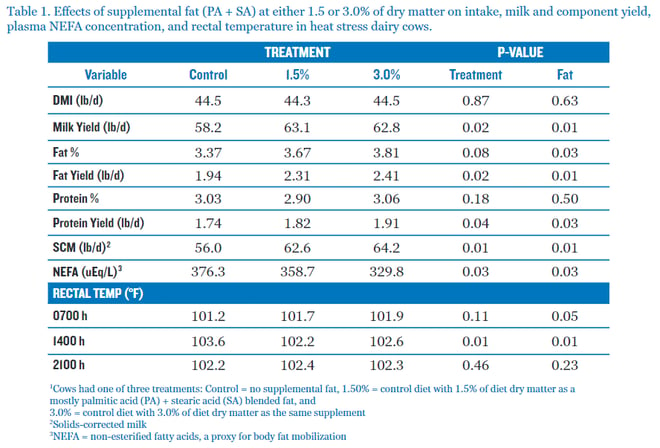In a study by Chan et al. (1997), cows were fed either a medium fat (4.6%) or a high fat (7.4%, with 3% coming from bypass fat as a mostly PA + SA supplement) ration in a shaded or active cooling system with sprinklers. There were no large significant differences in production, however cows that were in shade numerically increased butterfat concentration by 0.30% when adding the supplemental fat product. Adding fat also increased efficiency (FCM / DMI) numerically from 1.06 to 1.18 in shaded cows and from 1.15 to 1.21 in cooled cows when adding this saturated FA blend. Another publication by Wang et al. (2010) added a SA + PA blended fat at 0%, 1.5%, or 3% of the ration dry matter (DM) (Table 1). As 1.5% DM inclusion for supplemental fat is more typical in modern lactating dairy rations, this discussion will focus on that comparison. When adding 1.5% of diet DM as supplemental saturated FA from the control ration, cows maintained DMI but increased milk yield 4.9 lbs/d. Milk fat concentration and yield were increased by 0.30% and 0.37 lb/d, respectively, and milk protein yield was slightly increased. Moreover, there was a slight decrease in plasma concentration of non-esterified fatty acids (NEFA; a marker of the mobilization of body reserves for energy). During the hottest part of the day, the rectal temperatures of these cows was also slightly lower. Warntjes et al. (2008) fed a PA-enriched (86% C16:0) supplement during summer heat in California that reported no change in dry matter intake or ECM, as cows fed PA decreased in milk fat concentration but tended to increase milk yield.

FAT FEEDING DURING HEAT STRESS: SUPPLEMENTAL FAT BLENDS
There are many commercially available supplemental fat options that nutritionists and farmers can incorporate into their rations. Most of these are based on PA, SA, and oleic acid (OA; C18:1). Three major categories of commercial supplemental fats are those enriched in PA (>80% C16:0), calcium salts of palm FA (44 % PA + 36% OA), and PA + SA blends. All of these fats will increase energy density of the ration, but modern research has allowed us to understand more about the individual roles of these fatty acids and how they may affect cows in different stages of lactation and energy balance.
Supplementing with products enriched in PA consistently increases butterfat in a research setting, but there is not much research with feeding PA in heat-stressed cows. During heat stress, cows will back off feed, which may cause them to begin mobilizing additional body reserves for energy (particularly in early lactation), which can decrease reproductive success. Recent research with feeding PA in early lactation has shown that this type of supplement may exacerbate adipose tissue mobilization, which is also detrimental to reproduction. Calcium salts of palm FA contain a blend of PA + OA. Some recent research suggests that the OA portion may improve body condition in early and mid-lactation cows, but calcium salts can decrease DMI which may mitigate any benefit from increasing energy density of the ration. The OA portion is unsaturated, which increases the unsaturated FA load in the rumen and can add to risk of milk fat depression (especially if the cow is already dealing with acidosis).
Blends of PA and SA have been shown to maintain DMI when feeding at various levels, especially in comparison to calcium salt products (Harris et al., 2017; Sellers et al., 2017). Stearic acid is well-utilized by the cow for energy and may spare body reserves from having to be mobilized for energy. Recent meta-analyses have shown that PA + SA blends also increase milk and component yields (Hu et al., 2017; Sellers et al., 2017).
CHOOSING A SUPPLEMENTAL FAT FOR HEAT-STRESSED COWS
A supplemental fat for heat-stressed cows should be one that maintains or improves dry matter in-take, does not negatively affect rumen function, helps maintain body condition, and increases milk and component yield. Although products based on enriched PA are typically good for increasing butterfat concentration, there is minimal research with heat-stressed cows and excess PA may exacerbate adipose mobilization in early lactation cows which can decrease reproductive success.
Calcium salts of palm FA distillate have OA which may improve body condition but have been shown to decrease dry matter intake. If cows are already struggling with intakes during heat stress, this may not be the best choice. Energy Booster 100™ is a blend of PA + SA that maintains DMI, helps with energy balance and body condition, and increases ECM. Energy Booster 100™ is also available in a reacted form with 2.3% magnesium (EB-Mag™). EB-Mag™ has increased hardness and melting point, providing better handling at mills and on large farms. This product is a great choice for farms to continue to keep energy going into their heat-stressed cows and maintain body condition and milk and component production.
Learn more about fat feeding during heat stress.
Download the full white paper.


